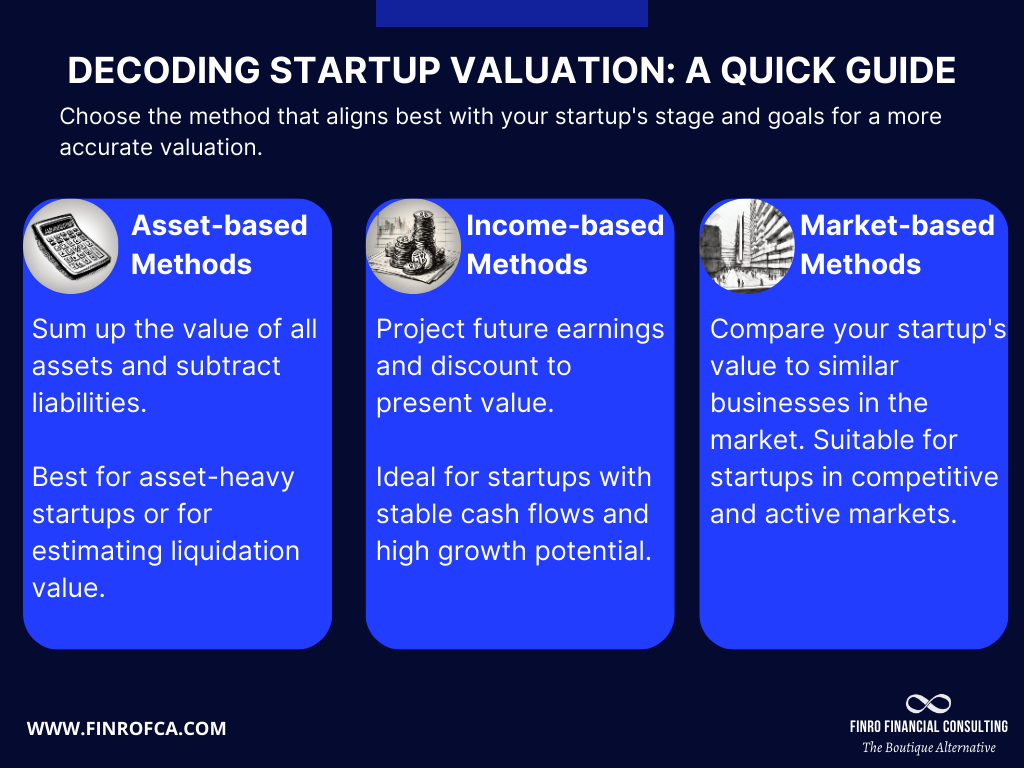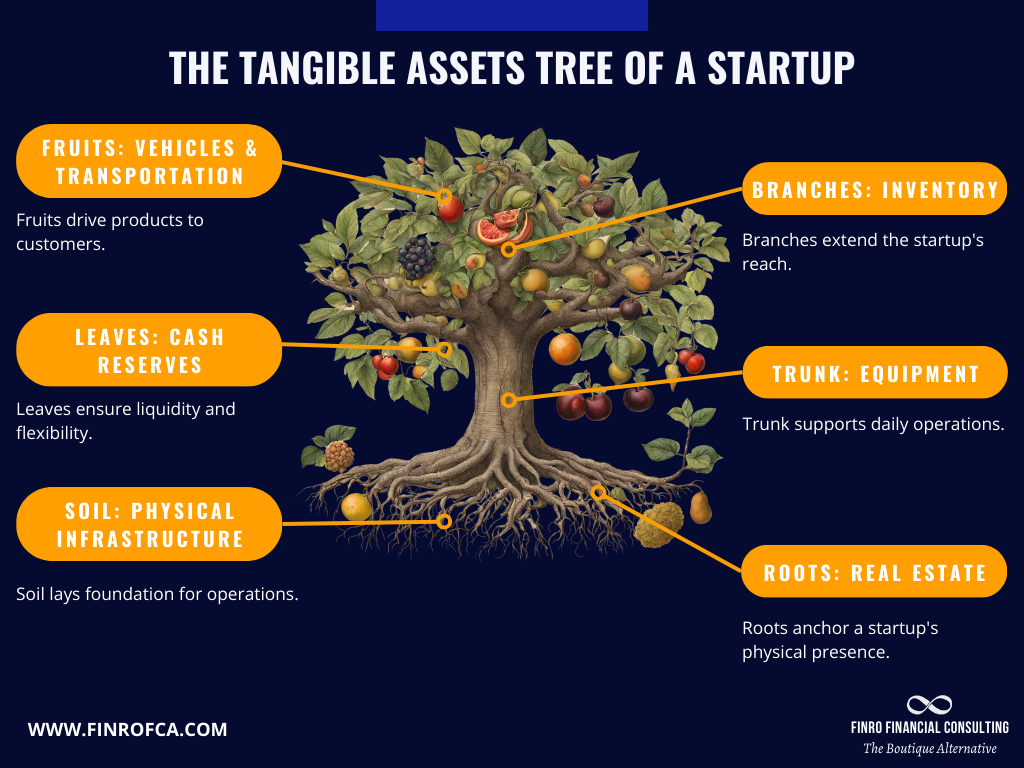Effective Business Valuation Methods For Startups
By Lior Ronen | Founder, Finro Financial Consulting
Embarking on the startup journey is an exhilarating experience, filled with visions of growth and success.
Yet, amidst the hustle of building a brand and scaling a business, there's a fundamental question that often surfaces: "What is my startup worth?" Whether you're seeking investment, contemplating a sale, or strategically planning your next move, understanding the value of your startup is crucial.
It's more than just numbers on a balance sheet; it's about recognizing your venture's potential and positioning in the market.
Wondering how much your startup is really worth? We've got you covered.
This guide breaks down the nitty-gritty of valuing your business, from counting assets and predicting cash flow to peeking at what similar companies are worth.
Plus, we'll point out some common pitfalls to steer clear of. Dive in to get a solid grip on your startup's value!
Valuing a startup, however, isn't a straightforward task. Traditional methods that work for established companies may not always apply to the dynamic and often unpredictable landscape of startups.
With factors like future potential, market demand, and even the charisma of the founding team at play, the valuation process can seem like a complex puzzle.
In this article, we aim to simplify this puzzle by delving into the most effective business valuation methods tailored for startups.
From assets and income projections to market comparisons, we'll explore various approaches and help you identify which method aligns best with your startup's stage, nature, and goals.
Understanding Asset-Based Valuation Methods
When attempting to determine the worth of your startup, one approach that often seems intuitive is the Asset-based valuation method. Essentially, this method computes your company's net value based on its tangible and intangible assets.
Tangible Assets
These are the physical elements that contribute to your startup's operations and services, including:
Equipment: Machinery, computers, and office furniture.
Inventory: Products or goods ready for sale.
Real Estate: Any owned office space or property.
Cash Reserves: Liquid funds available for use.
When assessing tangible assets, it's essential to value them based on their Fair Market Value (FMV). FMV is the price at which these assets would change hands between a willing buyer and a willing seller, with neither being under any compulsion to buy or sell and both having reasonable knowledge of the relevant facts. In simpler terms, it's the current market price that you could expect to receive for your assets if sold today.
Intangible Assets
Intangible assets, though not physical, can significantly boost your startup's worth. They include:
Goodwill: Your startup's reputation and brand strength.
Intellectual Property: Patents, copyrights, trademarks, or any proprietary technology or processes.
Customer Relationships: Established connections and contracts promising future income.
Valuing intangible assets, especially intellectual property, often requires specific valuation methods tailored to accurately estimate their worth.
These can include techniques such as the Income Method, which forecasts the expected future cash flows from the intellectual property, or the Cost-To-Duplicate Method, which is based on the idea that the value of an asset is equal to the cost of creating it plus an amount for profit.
Liabilities
It's essential not to overlook what your startup owes. Liabilities can include loans, debts, unpaid taxes, or any other outstanding financial obligations.
Calculating Net Value
The Asset-based valuation method calculates your startup's value as follows:
Value = (Tangible Assets + Intangible Assets) − Liabilities
When to Use Asset-Based Valuation
While the Asset-based method might seem straightforward, it’s particularly useful for startups with substantial tangible assets and relatively predictable earnings, such as those in the manufacturing or retail sectors.
It can also serve as a baseline for understanding the liquidation value of a startup – essentially, what would be left if everything were sold off.
However, this method may undervalue startups that rely heavily on future growth, innovation, or human capital, as these aspects are difficult to quantify as assets.
For instance, tech startups or service-oriented companies might find that this method doesn’t fully capture their potential worth.
Understanding the nuances and applicability of the Asset-based valuation method, along with how assets are accurately valued, is the first step in gauging your startup's worth.
But it's just one piece of the puzzle, and for a holistic view, other methods need to be explored as well.
Income-Based Valuation Methods
While asset-based methods focus on what a startup owns, income-based valuation methods take a different approach by emphasizing what a startup can earn.
For startups with promising growth prospects and strong income potential, this method might provide a more fitting valuation.
Let's explore two popular income-based approaches: the Discounted Cash Flow (DCF) method and the Capitalization of Earnings method.
Discounted Cash Flow (DCF): This method involves forecasting the future cash flows a startup is expected to generate and then discounting them back to their present value.
To discount the cash flows, a rate is applied that reflects the risk and opportunity cost associated with the investment. For instance, a startup with a revolutionary product might project substantial earnings in the future.
However, it's important to consider the uncertainties and risks, like market competition or changes in consumer behavior. By discounting the future earnings, the DCF method presents a realistic valuation today.
Capitalization of Earnings: This approach is simpler and usually used when a startup has a predictable and steady stream of earnings. The method involves dividing the annual earnings of the startup by a capitalization rate.
The capitalization rate reflects the perceived risk and expected growth of the business. Startups in well-established industries with stable revenues often use this method.
For example, a software-as-a-service (SaaS) startup with consistent subscription revenue might opt for the Capitalization of Earnings method to determine its value.
Both of these methods require some level of financial acumen, as they involve projecting future revenues, understanding risk, and determining appropriate discount or capitalization rates.
Startups need to be transparent and honest in their projections to ensure the valuations are accurate and trustworthy.
In conclusion, income-based valuation methods are crucial for startups with high growth prospects, allowing investors and stakeholders to peer into the future potential of the company.
It essentially answers the question: "What is the potential earning capacity of this startup, and what is that worth today
| Aspect | Discounted Cash Flow (DCF) | Capitalization of Earnings |
|---|---|---|
| Definition | Calculates the present value of projected future cash flows. | Values a business by dividing its annual earnings by a capitalization rate. |
| Complexity | Typically more complex due to forecasting and discounting future cash flows. | Simpler, as it's based on stable and predictable earnings. |
| Best Suited For | Suitable for startups with high growth and uncertain cash flows. | Ideal for businesses with consistent and steady revenues. |
| Risk Assessment | Uses a discount rate to account for risk and opportunity cost. | The capitalization rate reflects perceived risk and growth. |
| Time Horizon | Usually considers a longer-term forecast (5-10 years). | Often based on a single year's earnings. |
| Data Required | Needs detailed future cash flow projections. | Requires data on steady annual earnings. |
| Sensitivity to Changes | Sensitive to changes in assumptions and projections. | Less sensitive due to focus on stable earnings. |
Market-Based Methods
Market-based methods are like real estate appraisals for your startup. Imagine you want to know the value of your house. You'd probably look at the recent sale prices of similar houses in your neighborhood. In the same way, market-based methods compare your startup to similar businesses that have been sold or are available for sale.
1. Market Multiples Method
The Market Multiples Method is akin to comparing price tags. Suppose you're at a store comparing two similar shirts, both of the same quality, but one is priced higher. You'd naturally wonder why. Similarly, this method uses a financial metric, such as the price-to-earnings (P/E) ratio, to compare your startup with others in the same industry.
How it Works: Suppose the average P/E ratio in your industry is 15x, and your startup's earnings are $100,000. Your business could be valued at 15 x $100,000 = $1,500,000.
Pros: It's straightforward and easy to understand.
Cons: Finding an exact match in terms of business size, industry, and location can be challenging.
2. Comparable Transactions Method
Think of the Comparable Transactions Method as checking online reviews before buying a product. Just like you'd check what others paid for the same item, this method looks at the sale prices of similar businesses.
How it Works: If a comparable startup was sold for $2 million recently and your startup has similar characteristics, it could be valued around the same ballpark.
Pros: It's grounded in real-world data.
Cons: Adjustments for differences in size, location, and condition can be subjective.
Best Suited For:
Market-based methods work well for startups in competitive and active markets or those with unique value propositions. They're ideal when there is sufficient data on comparable businesses.
Challenges and Considerations:
These methods might seem straightforward, but their effectiveness depends on the quality and availability of data. The more comparable businesses you can find, the more accurate the valuation will be.
| Criteria | Market Multiples Method | Comparable Transactions Method |
|---|---|---|
| Definition | Compares financial metrics (e.g., P/E ratio) with industry averages. | Examines the sale prices and terms of similar businesses. |
| How it Works | Multiplies a financial metric by the industry average. | Looks at recent sale prices of similar businesses and adjusts. |
| Pros | Straightforward, easy to understand. | Grounded in real-world data, considers actual transactions. |
| Cons | May struggle to find an exact match. | Adjustments for differences can be subjective. |
| Best Suited For | Startups in industries with clear benchmarks. | Startups in active markets with sufficient transaction data. |
| Challenges | Limited data may lead to inaccurate valuations. | Requires detailed knowledge and data of past transactions. |
Choosing the Right Valuation Method for Your Startup
Determining your startup's value is a crucial step in your entrepreneurial journey.
To make this task less daunting and more precise, it's important to select an appropriate valuation method tailored to your business.
Below, we delve into several factors to consider when making this choice:
1. Stage of Your Startup:
Early-stage Startups: If your business is still in its infancy, perhaps yet to generate consistent revenue, but with promising growth potential, methods like the Comparables Method or Precedent Transactions may be more suitable. These methods assess your startup's value by drawing parallels with similar businesses or recent transactions in your sector.
Mature Startups: For startups that have passed the initial hurdles and have established a steady flow of revenue, Discounted Cash Flow (DCF) or Capitalization of Earnings methods may provide a more accurate reflection of their current and future worth.
2. Industry Norms:
The industry your startup operates in can dictate the most accepted valuation methods. For instance, fast-growing tech startups might prefer using market comparables due to the sector's dynamic nature and potential for exponential growth.
3. Data Availability:
Methods such as Market Multiples and Comparable Transactions require access to substantial data on similar businesses and their transactions. If obtaining such data is challenging, these methods may not yield an accurate valuation.
4. Purpose of Valuation:
For Sale or Investment: If you are valuing your startup with the intent to attract investors or buyers, Income-based Methods can showcase your profitability, while Market-based Methods can underscore your market relevance and competitiveness.
Internal Assessment: If you're evaluating internally or gearing up for potential liquidation, Asset-based Methods can provide a clear picture of your tangible and intangible assets.
5. Complexity and Cost:
DCF is a thorough and detailed method but can be intricate, often necessitating professional expertise, which can elevate costs.
On the flip side, simpler alternatives like Market Multiples can be cost-effective and easier to apply, offering a quick snapshot of your startup's value.
6. Future Revenue Expectations:
If your startup’s revenues are expected to experience significant ups and downs, the DCF method can offer a nuanced analysis. In contrast, startups with consistent earnings might find Capitalization of Earnings more fitting.
7. Intangible Assets and Brand Value:
For startups that boast considerable intangible assets, such as brand recognition, intellectual property, or proprietary technology, considering valuation methods that take these into account, such as Market Comparables, is essential.
8. Agility and Periodic Reevaluation:
The business landscape can shift rapidly. Hence, it is prudent to periodically reassess your startup's valuation method to ensure it remains in alignment with your evolving circumstances and industry trends.
In conclusion, while there is no one-size-fits-all approach to startup valuation, often employing a combination of methods can lead to a more holistic and realistic valuation.
By carefully aligning the valuation method with your startup’s distinctive characteristics and objectives, you can attain a valuation that truly mirrors your business's value and potential.
Common Mistakes in Startup Valuation and How to Avoid Them
Valuing a startup can be an intricate process, with various pitfalls that entrepreneurs may encounter along the way.
Being aware of these common mistakes can help you navigate the valuation journey with greater accuracy and confidence.
1. Overestimating Future Revenues:
Mistake: Startups, especially in their initial stages, often fall into the trap of overestimating their future revenues, leading to inflated valuations.
Solution: Adopt a conservative approach while projecting revenues. Consider historical data, industry trends, and potential risks in your calculations to ensure a realistic estimate.
2. Neglecting the Importance of Intangible Assets:
Mistake: Tangible assets are easily quantifiable, but intangible assets like intellectual property, brand value, and network effects are often overlooked.
Solution: Take stock of your intangible assets and use appropriate methods to incorporate them into your valuation, ensuring a comprehensive assessment.
3. Using a Single Valuation Method:
Mistake: Relying solely on one method may not capture the multifaceted nature of a startup’s value.
Solution: Employing a combination of valuation methods can offer a more well-rounded and accurate estimation of your startup's worth.
4. Disregarding Market Conditions:
Mistake: Overlooking the current state of the market or industry can lead to miscalculations.
Solution: Stay abreast of market conditions, industry trends, and comparable transactions to align your valuation with the current landscape.
5. Overlooking Liabilities:
Mistake: Not factoring in debts, liabilities, or contingent liabilities can lead to a skewed valuation.
Solution: Ensure all liabilities, including potential legal disputes or debts, are meticulously accounted for in the valuation.
6. Emotional Valuation:
Mistake: Sometimes, the emotional investment in a startup can cloud an entrepreneur's judgment, leading to overvaluation.
Solution: Aim for an unbiased and objective approach. Seeking external expertise can bring a fresh, impartial perspective to the valuation process.
7. Ignoring Scalability and Sustainability:
Mistake: Focusing solely on the present without considering the scalability and sustainability of the business model can be detrimental.
Solution: Evaluate whether the startup has a scalable and sustainable business model, which is often a key consideration for investors.
8. Lack of Periodic Re-evaluation:
Mistake: Considering valuation as a one-time task rather than an ongoing process.
Solution: Regularly revisit and revise your startup's valuation, taking into account shifts in market conditions, progress, and any new challenges faced.
By being mindful of these common pitfalls and adopting proactive strategies to avoid them, startups can ensure that their valuation is not only accurate but also reflective of their true potential and market standing.
Conclusion: Navigating the Valuation Journey with Precision and Insight
Determining the value of a startup is much like navigating uncharted territory. Each journey is unique, presenting its own set of challenges and opportunities.
From tangible assets like equipment and inventory to intangible assets such as brand value and intellectual property, every facet of a startup contributes to its overall worth.
As we've explored, methodologies like asset-based, income-based, and market-based valuation offer different perspectives and can be instrumental in painting a comprehensive picture of a startup's value.
However, the path is fraught with common mistakes, such as overestimating revenues or neglecting the importance of intangible assets. Being cognizant of these pitfalls and approaching the valuation process with a balanced and informed mindset is crucial.
By combining multiple valuation methods, staying attuned to market conditions, and regularly re-evaluating your startup’s worth, you can derive a valuation that is both fair and favorable.
Ultimately, a startup's valuation is not just a reflection of its current standing but also a testament to its potential and promise.
As an entrepreneur, understanding the nuances of valuation equips you with the knowledge to drive negotiations, secure investments, and steer your startup towards sustained growth and success. In this journey, precision, insight, and adaptability are your trusted allies, ensuring that your startup's value is recognized and realized in the competitive landscape.
So, as you embark on the journey of valuing your startup, remember that the process is as dynamic and evolving as the startup itself. Approach it with diligence, curiosity, and a readiness to adapt, and watch your startup navigate the path to success with confidence.







